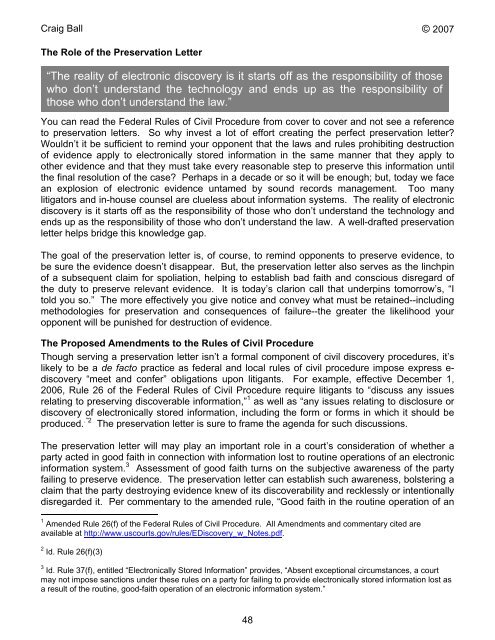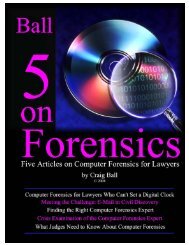Six Articles on Electronic - Craig Ball
Six Articles on Electronic - Craig Ball
Six Articles on Electronic - Craig Ball
Create successful ePaper yourself
Turn your PDF publications into a flip-book with our unique Google optimized e-Paper software.
<strong>Craig</strong> <strong>Ball</strong> © 2007<br />
The Role of the Preservati<strong>on</strong> Letter<br />
“The reality of electr<strong>on</strong>ic discovery is it starts off as the resp<strong>on</strong>sibility of those<br />
who d<strong>on</strong>’t understand the technology and ends up as the resp<strong>on</strong>sibility of<br />
those who d<strong>on</strong>’t understand the law.”<br />
You can read the Federal Rules of Civil Procedure from cover to cover and not see a reference<br />
to preservati<strong>on</strong> letters. So why invest a lot of effort creating the perfect preservati<strong>on</strong> letter?<br />
Wouldn’t it be sufficient to remind your opp<strong>on</strong>ent that the laws and rules prohibiting destructi<strong>on</strong><br />
of evidence apply to electr<strong>on</strong>ically stored informati<strong>on</strong> in the same manner that they apply to<br />
other evidence and that they must take every reas<strong>on</strong>able step to preserve this informati<strong>on</strong> until<br />
the final resoluti<strong>on</strong> of the case? Perhaps in a decade or so it will be enough; but, today we face<br />
an explosi<strong>on</strong> of electr<strong>on</strong>ic evidence untamed by sound records management. Too many<br />
litigators and in-house counsel are clueless about informati<strong>on</strong> systems. The reality of electr<strong>on</strong>ic<br />
discovery is it starts off as the resp<strong>on</strong>sibility of those who d<strong>on</strong>’t understand the technology and<br />
ends up as the resp<strong>on</strong>sibility of those who d<strong>on</strong>’t understand the law. A well-drafted preservati<strong>on</strong><br />
letter helps bridge this knowledge gap.<br />
The goal of the preservati<strong>on</strong> letter is, of course, to remind opp<strong>on</strong>ents to preserve evidence, to<br />
be sure the evidence doesn’t disappear. But, the preservati<strong>on</strong> letter also serves as the linchpin<br />
of a subsequent claim for spoliati<strong>on</strong>, helping to establish bad faith and c<strong>on</strong>scious disregard of<br />
the duty to preserve relevant evidence. It is today’s clari<strong>on</strong> call that underpins tomorrow’s, “I<br />
told you so.” The more effectively you give notice and c<strong>on</strong>vey what must be retained--including<br />
methodologies for preservati<strong>on</strong> and c<strong>on</strong>sequences of failure--the greater the likelihood your<br />
opp<strong>on</strong>ent will be punished for destructi<strong>on</strong> of evidence.<br />
The Proposed Amendments to the Rules of Civil Procedure<br />
Though serving a preservati<strong>on</strong> letter isn’t a formal comp<strong>on</strong>ent of civil discovery procedures, it’s<br />
likely to be a de facto practice as federal and local rules of civil procedure impose express e-<br />
discovery “meet and c<strong>on</strong>fer” obligati<strong>on</strong>s up<strong>on</strong> litigants. For example, effective December 1,<br />
2006, Rule 26 of the Federal Rules of Civil Procedure require litigants to “discuss any issues<br />
relating to preserving discoverable informati<strong>on</strong>,” 1 as well as “any issues relating to disclosure or<br />
discovery of electr<strong>on</strong>ically stored informati<strong>on</strong>, including the form or forms in which it should be<br />
produced. .”2 The preservati<strong>on</strong> letter is sure to frame the agenda for such discussi<strong>on</strong>s.<br />
The preservati<strong>on</strong> letter will may play an important role in a court’s c<strong>on</strong>siderati<strong>on</strong> of whether a<br />
party acted in good faith in c<strong>on</strong>necti<strong>on</strong> with informati<strong>on</strong> lost to routine operati<strong>on</strong>s of an electr<strong>on</strong>ic<br />
informati<strong>on</strong> system. 3 Assessment of good faith turns <strong>on</strong> the subjective awareness of the party<br />
failing to preserve evidence. The preservati<strong>on</strong> letter can establish such awareness, bolstering a<br />
claim that the party destroying evidence knew of its discoverability and recklessly or intenti<strong>on</strong>ally<br />
disregarded it. Per commentary to the amended rule, “Good faith in the routine operati<strong>on</strong> of an<br />
1 Amended Rule 26(f) of the Federal Rules of Civil Procedure. All Amendments and commentary cited are<br />
available at http://www.uscourts.gov/rules/EDiscovery_w_Notes.pdf.<br />
2 Id. Rule 26(f)(3)<br />
3 Id. Rule 37(f), entitled “Electr<strong>on</strong>ically Stored Informati<strong>on</strong>” provides, “Absent excepti<strong>on</strong>al circumstances, a court<br />
may not impose sancti<strong>on</strong>s under these rules <strong>on</strong> a party for failing to provide electr<strong>on</strong>ically stored informati<strong>on</strong> lost as<br />
a result of the routine, good-faith operati<strong>on</strong> of an electr<strong>on</strong>ic informati<strong>on</strong> system.”<br />
48













